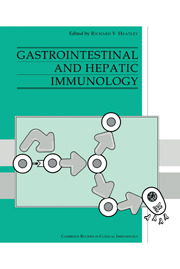Book contents
- Frontmatter
- Contents
- List of contributors
- Preface
- 1 Lymphoid cells and tissues of the gastrointestinal tract
- 2 Lymphocyte migration to the gut mucosa
- 3 Regulating factors affecting gut mucosal defence
- 4 Gastritis
- 5 The immunology of coeliac disease
- 6 Inflammatory bowel disease
- 7 Food intolerance and allergy
- 8 Gastrointestinal and liver involvement in primary immunodeficiency
- 9 Secondary immunodeficiency – the acquired immunodeficiency syndrome (AIDS)
- 10 Intestinal infections
- 11 Lymphomas
- 12 Small bowel transplantation
- 13 Clinical aspects of immunologically mediated intestinal diseases
- 14 Chronic active hepatitis
- 15 Primary biliary cirrhosis
- 16 Immunology and immunopathology of acute viral hepatitis
- 17 Immunology of liver transplantation
- 18 Clinical correlates with hepatic diseases
- Index
11 - Lymphomas
Published online by Cambridge University Press: 03 February 2010
- Frontmatter
- Contents
- List of contributors
- Preface
- 1 Lymphoid cells and tissues of the gastrointestinal tract
- 2 Lymphocyte migration to the gut mucosa
- 3 Regulating factors affecting gut mucosal defence
- 4 Gastritis
- 5 The immunology of coeliac disease
- 6 Inflammatory bowel disease
- 7 Food intolerance and allergy
- 8 Gastrointestinal and liver involvement in primary immunodeficiency
- 9 Secondary immunodeficiency – the acquired immunodeficiency syndrome (AIDS)
- 10 Intestinal infections
- 11 Lymphomas
- 12 Small bowel transplantation
- 13 Clinical aspects of immunologically mediated intestinal diseases
- 14 Chronic active hepatitis
- 15 Primary biliary cirrhosis
- 16 Immunology and immunopathology of acute viral hepatitis
- 17 Immunology of liver transplantation
- 18 Clinical correlates with hepatic diseases
- Index
Summary
Introduction
The gastrointestinal tract is the commonest site of primary extra-nodal lymphoma, accounting for 30–50% of cases (Freeman, Berg & Cutler, 1972, Otter et al., 1989). The lymphomas are almost exclusively non–Hodgkin's type, primary gastrointestinal Hodgkin's disease being extremely rare. There is considerable geographic variation in the incidence of primary gastrointestinal lymphoma: the highest incidence is in the Middle East where 25% of all lymphomas arise in the gastrointestinal tract. In Western countries, gastrointestinal lymphoma comprises 4–18% of all non–Hodgkin's lymphoma, but this incidence may be increasing (Hayes & Dunn, 1989, Azab et al., 1989).
Primary nodal lymphoma involves the gastrointestinal tract as a secondary phenomenon in up to 25% of cases (Fischbach et al., 1992). Strict criteria have therefore been applied for the diagnosis of primary gastrointestinal lymphoma, requiring that the lymphoma be limited to the gastrointestinal tract and contiguous lymph nodes (Dawson, Cornes & Morson, 1961). While ensuring that such lymphomas truly arise in the gastrointestinal tract such a strict definition excludes the possibility of disseminated primary gastrointestinal lymphoma and skews survival data towards a favourable prognosis. The recognition that some primary gastrointestinal lymphomas are morphologically and immunophenotypically distinct has, to a certain extent, circumvented this problem.
With the possible exception of cerebriform T cell lymphoma, any lymphoma listed in the standard lymphoma classifications may arise in the gastrointestinal tract. In terms of frequency, however, the types of lymphoma occurring in the peripheral lymph nodes and the gastrointestinal tract are quite different.
- Type
- Chapter
- Information
- Gastrointestinal and Hepatic Immunology , pp. 217 - 234Publisher: Cambridge University PressPrint publication year: 1994

